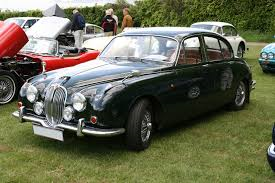-
Insurance
InsuranceAbout our productsLearn about insuringGet a quote Get current values, historical values, model history and more.
-
Valuation
ValuationHagerty valuation toolLook up a vehicle value Get current values, historical values, model history and more.
-
Events
EventsHagerty official eventsHagerty ClubhouseEvent calendar
-
Entertainment
EntertainmentMore to explore
- Portal login
1969 Jaguar 240
Base 4dr Saloon 2.5 L
Vehicle values by condition
Fair
Condition 4
£5,800
#4 cars are daily drivers, with flaws visible to the naked eye. The chrome might have pitting or scratches, the windshield might be chipped.
Good
Condition 3
£10,400
#3 cars could possess some, but not all of the issues of a #4 car, but they will be balanced by other factors such as a fresh paint job or a new, correct interior.
Excellent
Condition 2
£16,500
#2 cars could win a local or regional show. They can be former #1 cars that have been driven or have aged. Seasoned observers will have to look closely for flaws.
Concours
Condition 1
£27,700
#1 vehicles are the best in the world. The visual image is of the best car, unmodified, in the right colours, driving onto the lawn at the finest concours.
Insurance premium for a
1969 Jaguar 240 Base 4dr Saloon 2483
valued at £10,400
£126.07
/ year*
History of the 1967 - 1969 Jaguar 240

1967 - 1969 Jaguar 240
Jaguar 240/340 (Saloon), 1967-1969
The Jaguar 240/340 was in production from 1967 until 1969. Styled by Sir William Lyons, it is a front- engine, rear wheel drive saloon car seating five people.
The Jaguar 240/340 was the final iteration of the MkII, Jaguar's small saloon range. The MkII had been around for eight years, but Jaguar's new XJ range wasn't ready. To keep the MkII selling, prices needed to come down to a more palatable level whereby people might conceivably buy the Jag instead of a Rover P6 or Triumph 2000. To do this, Jaguar needed to economise. So the bumpers were replaced by S-Type aping slimline jobs, the leather upholstery gave way to Ambla, the standard foglamps were gone in place of horn grilles, and a number of other subtle tweaks were made. For fans of the 2.4 this was good news - the new 240 was far swifter than the outgoing 2.4 MkII. But 3.8 fans would be sad to see their favourite stop production. A handful of unofficial 380s and 240 3.8s were made, but neither option was ever listed for sale.
The 240's power gain was due to a new straight port head and twin SUs in favour of the earlier Solexes. These raised power by some 10%, to 133bhp. The 3.4 litre 340 was available with optional power steering, and both models received a new Borg Warner 35 automatic transmission. Barring that they were the same as the earlier models, meaning monocoque construction, XK engines, Jaguar four speed manual gearbox with optional overdrive, and a live axle in contrast to Jaguar's otherwise universal IRS setup.
The 340 was discontinued in 1968 when the XJ6 was launched, but the final 240s lingered as an entry level model until 1969. By then, they cost £1362 - just £20 more than the 2.4 MkII at launch. 7246 were built - 4446 240s and 2788 340s, with 12 380s unofficially built too.
The 240/340 feels like a MkII to drive - so, without power steering, a fairly heavy thing. That's not to say unpleasant, more that you can tell there's some heft to it. Even the 240 is quick enough for most people, while the 340 was very nearly as quick as the old 3.8. You can provoke a MkII, but the roll you encounter beforehand will make it safe for all but the most determined of sporting drivers. It feels advanced to say it's a 1950s design, but perhaps not as forward thinking as the Rover against which it competed.
It's a MkII by any other name - meaning that spares are just as easy to get from specialists including SNG Barratt. Trim items are common to other Jags, while the drivetrain did for most of the range between the mid 1950s and mid 1980s in some form or other. Spares arethus not hard to source, though the fact these cars were built to a cost means that they're prone to rot. Check the lower extremities thoroughly with that in mind, and expect some filler in most examples on sale.
Just 12 380s were made, and their rarity and large engine make these the most collectible and desirable of the slim bumper MkII successors. Following that, the 340 is rarer and faster than the 240, and naturaly more valuable. Automatics are slow sellers in comparison with manuals, and wire wheels and power steering are both seen as advantageous. Best bargain would be the 240 automatic, though you may struggle to sell it.
Jaguar hoped the 240 and 340 might be seen as competitors to the Rover 2000TC and 3500, while entry level Mercedes models were similarly priced. Cars like the Humber Sceptre were cheaper but far more modern in design. Nowadays, Neue Klasse BMWs might also be considered. Of course, there's always the Turner engined Daimler V8-250 if you fancy a 240 but want to be different.
Hagerty Newsletter
Get your weekly dose of car news from Hagerty UK in your inbox

ADVERTISEMENT